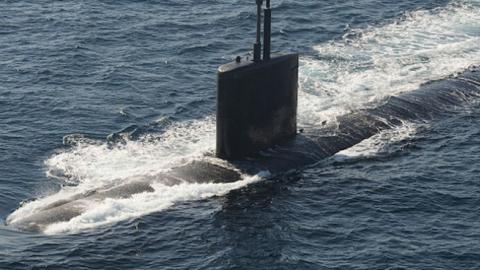The U.S. Navy’s latest shipbuilding plan would see its attack submarine fleet diminish from 55 to 41 boats in the next decade and a half. That decision, confirmed in August, was eclipsed by the advance of ISIL, war in Gaza, and sedition in Ukraine. But the Navy’s announcement—the single-largest strategic consequence of this administration’s defense cuts—has the most far-reaching ramifications of the summer’s events.
The United States faces the prospect of drawn-out tension leading to possible conflict on two fronts, the Middle East and the Far East. Of the two, Chinese ambition will require more attention. It is supported by growing wealth, expanding military power, and abundant patience. The challenges these generate are likely to remain a century from now. China’s leadership, meanwhile, will confront a host of problems in the next 15 years—when the U.S. attack submarine fleet will be a quarter smaller than it is today—including an aging population that can’t sustain the optimistic predictions for China’s economy. As Nick Eberstadt notes, 15 years from now, because of the preference for male babies, 20 to 40 percent of rural, uneducated 30-year-old Chinese men will not be able to find mates—with large and unknowable possibilities for turmoil. Over the same period, competing regional markets’ lower labor, utility, and rent costs will becalm the expanding economy on which China’s authoritarian leaders have justified their rule. A multitude of state-owned industries employing millions are already seeing the loans they need to stay afloat failing to perform; more could follow.
Equally troubling is a political class whose hegemonic ambition matches its contempt for international agreements. Consider the National People’s Congress decision to renege on China’s 1984 signed promise to allow Hong Kong’s political arrangements to continue intact for 50 years. In August, Hong Kong’s voters were told that they will select their senior political official in the 2017 elections from a slate approved by a mostly pro-Beijing nominating committee. At the same time, China’s increasing challenges to many of its neighbors over territorial issues in the international waters of the South and East China Seas are nourishing a spirit in surrounding states that could mature into determined opposition. In short, China’s internal pressures are mounting in parallel with external aggression.
China, however, possesses one advantage not of its own making. The chances that the United States will be there to organize and lead the states that fear China are dimming as the gulf between the ships the Navy needs and the ships it can afford widens. What China will have to show for throwing its weight around in the region depends on what the United States does to preserve its dominance as a Pacific naval power. On that score, the strategic importance of the Navy’s decision to cut its attack submarine fleet by 25 percent cannot be overstated.
Beijing aims to keep the U.S. Navy out of range of Asia. Its large investments in naval aviation, cyber warfare, a modernizing surface and submarine fleet, a fledgling carrier force, and a ballistic missile intended to sink or put out of service U.S. aircraft carriers place at risk our bases in the region and interrupt our communication with allies. If wielded successfully, these measures will assure the safety of China’s navy and mainland and end our run as the West Pacific’s great power.
But China’s strategy is vulnerable—chiefly to submarines. Subs are very difficult to detect and cannot be targeted by missiles while underway. They can demolish an enemy’s fleet and their cruise missiles can destroy targets ashore. As a hedge against China’s anti-access strategy, submarines are matchless. Long-distance drones launched from carriers at a safe distance will eventually offset the dangers of China’s ship-hitting ballistic missiles. Then it will be but a question of time until China adds to its missiles’ range. So long as submarines remain stealthy, they bypass the age-old technological cat-and-mouse game of countering an adversary’s technology and in turn being countered.
Because of its war-fighting abilities, a robust attack submarine fleet is also a highly persuasive deterrent against conflict itself. But the idea of deterrence is missing from Obama administration thinking. When a Chinese jet fighter approached within yards of a U.S. Navy surveillance plane in international air space in mid-August, the State Department sent a disapproving letter. China responded that the United States must cease its patrols over international waters or face more dangerous encounters. Notwithstanding repeated parallel incidents in international waters against U.S. allies in the region over the past couple of years, China was invited to join the United States and those same Asian allies in an annual U.S.-led naval exercise the previous month. The plan for a diminished attack sub fleet is a broader expression of the Obama administration’s hopeful idea—not shared by Chinese leaders—that there exists no strategic competition between China and the United States.
The president’s refusal to build defenses, harness them as legitimate instruments of international persuasion, and actually use them is—in conjunction with his skepticism about the morality of American leadership—as responsible for the growing international chaos as it is incapable of preventing its metastasis. USS George H. W. Bush, for example, which has been using a minuscule portion of its powerful strike force against ISIL for the past few weeks, was the only U.S. aircraft carrier in the region. The two-carrier presence that the United States had previously maintained ended last year as a cost-saving measure and as an encouragement to Iran for a deal over its nuclear weapons program. The single remaining American carrier had been patrolling the northern Arabian Sea supporting the withdrawal of U.S. equipment from Afghanistan. Its departure for the Persian Gulf left a hole in the Afghan mission that could only be filled by ground-based attack planes—which are also scheduled to be withdrawn.
Meanwhile, Vladimir Putin’s ambition for a reborn Russian empire is fanning blazes that begin in Moldova and reach through Crimea, Ukraine, and end—for now—in Abkhazia and South Ossetia. Turkey’s Islamist president Recep Tayyip Erdogan openly supports Hamas, has facilitated the transit of Westerners crossing the Syrian border to join ISIL, and holds an international record for the number of imprisoned journalists. The territory south of Asia Minor is in a turmoil whose end cannot be seen. All these lands are either joined by, or set back from, the Black Sea. The great power conflicts that overlapping areas of interest ignited in the mid-19th-century Crimean War and concentrated again, with bloody results, at Gallipoli six decades later are likely to engage American attention for years.
The paucity of carriers where they are—or might soon be—needed is a here-and-now crisis. But it is congruent with, and a harbinger of, the strategic crisis that will unfold if the political will cannot be found to build the U.S. attack submarine fleet at a rate to assure, at a minimum, its current strength over the next three decades, as events around the globe point toward a darkening future.
__This article originally appears in the October 6, 2014, Vol. 20, No. 04 issue of the Weekly Standard.__
















